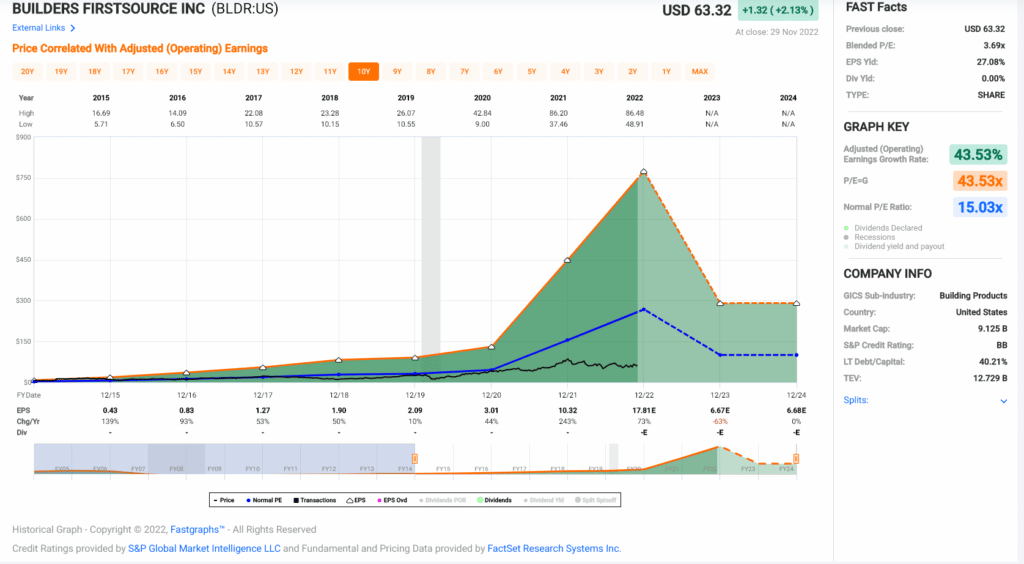Here’s something interesting pointed out by the Financial Times’ U.S. financial commentator, Robert Armstrong: industrial stocks have done well lately—really well. Since September 30, the S&P 500 industrials are up 20%, nearly double the full index.
Armstrong noted that of the 71 S&P industrial stocks, 58 have outperformed the index since the end of September, and only one stock, Generac Holdings Inc. (GNRC), has fallen.
This is unusual, to say the least, because there is a widespread expectation that a recession is coming soon. Industrial stocks are cyclical, and therefore supposed to perform poorly heading into an economic downturn.
Many of those who expect a recession do so because the Treasury 10-year 3-month yield curve is very inverted. Yet shares in construction equipment company Caterpillar Inc. (CAT) and farming equipment firm Deere & Co. (DE) have both recently traded at all-time highs!
Let’s take a closer look at Caterpillar, which is up more than 40% since the end of September and has a decent dividend yield—in excess of 2%—as well.
Caterpillar Performing Smoothly
Caterpillar, founded in 1925, is one of America’s premier industrial companies. It is the world’s leading manufacturer of construction and mining equipment, diesel and natural gas engines, industrial gas turbines, and diesel-electric locomotives.
Caterpillar has three primary business segments: Construction Industries (approximately 41% of 3Q sales), Resource Industries (18% of 3Q sales) and Energy & Transportation (41% of 3Q sales).
The company impressed investors by delivering growth in both its top- and bottom-lines for the last few quarters, despite inflationary pressures and supply-chain snarls. In fact Caterpillar increased equipment sales in the third quarter by 22% year on year to $14.2 billion.
The company’s adjusted earnings per share were $3.95 in third-quarter 2022, surpassing Wall Street estimates. The bottom-line figure marked a 48.5% improvement year over year, and the adjusted operating margin widened by 280 basis points to 16.2%. For the first nine months of the year, the company has earned $10.01 per share on an adjusted basis.
Caterpillar’s backlog at the end of the quarter was an impressive $30 billion, up by $1.6 billion.
This bodes very well for its top-line performance in future quarters. Caterpillar did not give full-year earnings guidance, but management has indicated that sales in the fourth quarter should be the highest of the year and that it is expecting a “strong” fourth-quarter adjusted operating margin.
CAT: Dividend Aristocrat
Caterpillar’s cash and liquidity position remains strong, ending the third quarter of 2022 with cash and short-term investments of $6.3 billion.
In June 2022, Caterpillar hiked its quarterly dividend 8%, to $1.20 per share. This was a case of management signaling confidence in the near-term outlook, despite the supply chain and inflationary difficulties, and it maintained Caterpillar’s status as a dividend aristocrat. The company, which has paid dividends since 1933, continues its 28-year streak of paying increasingly higher dividends to its shareholders.
Caterpillar’s dividend yield and payout ratio are higher than its peers. Over the past four years, CAT has returned an average of 99% of its machinery, energy, and transportation segments’ free cash flow to its shareholders. This is in sync with its target of returning all free cash flow from these segments to the shareholders over time.
The estimated dividend for 2022 is $4.71, and it’s at least $5.08 for 2023.
Buy Caterpillar
Morningstar had a great summation as to why Caterpillar is such a great long-term investment. Here is what Morningstar said:
We think Caterpillar will continue to be the leader in the global heavy machinery market, providing customers an extensive product portfolio consisting of construction, mining, energy, and transportation products. For nearly a century, the company has been a trusted manufacturer of mission-critical heavy machinery, which has led to its position as one of the world’s most valuable brands. Caterpillar’s strong brand is underpinned by its high-quality, extremely reliable, and efficient products.
I would add that customers also value Caterpillar’s ability to offer the lowest total cost of equipment ownership in its market segment, as well as value-added services through the company’s extensive global dealer network of about 2,700 offices.
Also attractive: Caterpillar offers a wide range of products that enhance fuel efficiency, thanks to its diesel-electric and electric drivetrain product offerings. And more than one million of its two million machines in the field are connected to its digital platform.
I believe Caterpillar has a lot of strong structural tailwinds in its favor.
One of these tailwinds is the increased infrastructure spending in both the U.S. and emerging markets, which will boost sales of Caterpillar’s construction equipment. Plus, increased spending on energy—both oil and gas as well as renewable—will boost demand for the company’s mining equipment, in addition to its well-servicing equipment (pumps, engines, etc.).
Add it all up and Caterpillar is a buy anywhere in the low-to-mid $200s.
It’s not REITs or blue chips like Disney. A small, little-talked about area of the dividend stock market is pumping out market-beating returns like no tomorrow. Over 22 years, they’ve handily beat the market… and I have the #1 stock of these to give you now.










